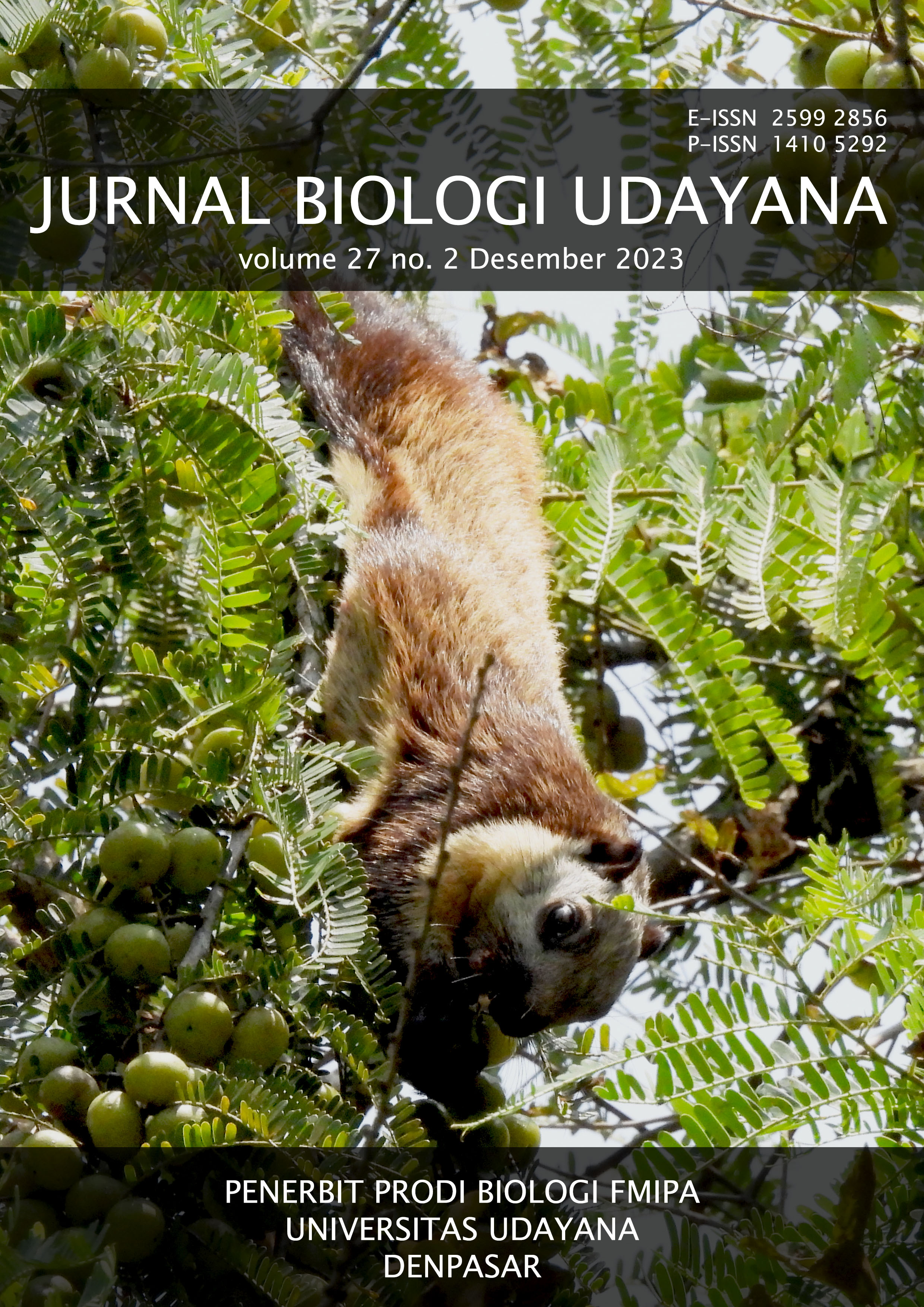The Pertumbuhan dan produktivitas kacang merah (Phaseolus vulgaris L.) setelah pemberian eco enzyme limbah tebu pada tanah gambut
Abstract
Kacang merah (Phaseolus vulgaris L.) merupakan salah satu komoditas sayuran Provinsi Kalimantan Barat yang memiliki produksi rendah jika dibandingkan dengan komoditas sayuran lainnya. Beberapa upaya dilakukan untuk meningkatkan hasil produksi kacang merah (Phaseolus vulgaris L.) salah satunya dengan pemberian pupuk organik cair. Bahan organik seperti limbah tebu banyak dijumpai di Kota Pontianak dan dapat digunakan dalam pembuatan pembuatan eco enzyme yang dapat digunakan sebagai pupuk organik bagi tanaman kacang merah (Phaseolus vulgaris L.). Tujuan dari penelitian ini adalah untuk mengetahui pengaruh pemberian eco enzyme limbah tebu terhadap pertumbuhan dan produksi kacang merah (Phaseolus vulgaris L.). Penelitian ini menggunakan Rancangan Acak Lengkap (RAL) dengan 7 taraf perlakuan yaitu POC Green Tonik (kontrol positif), 0 mL/L eco enzyme (kontrol negatif), 0,5 mL/L eco enzyme (A1), 1 mL/L eco enzyme (A2), 1,5 mL/L eco enzyme (A3), 2 mL/L eco enzyme (A4) dan 2,5 mL/L eco enzyme (A5). Hasil penelitian menunjukkan bahwa pemberian eco enzyme limbah tebu berpengaruh nyata terhadap tinggi tanaman, kadar klorofil, berat basah biji dan berat kering biji tanaman kacang merah (Phaseolus vulgaris L.). Pemberian eco enzyme dengan konsentrasi 2,5 mL/L memberikan hasil terbaik untuk parameter pertumbuhan tinggi tanaman 53 cm dan kadar klorofil 3,19 mg/L. Sedangkan pemberian eco enzyme dengan konsentrasi 1 mL/L memberikan hasil terbaik untuk parameter produksi berat basah biji 3,64 g dan berat kering biji 0,80 g.
Downloads
References
Apriliani A . (2010). Pemanfaatan Arang Ampas Tebu sebagai Adsorben Ion Logam Cd, Cr, Cu, dan Pb dalam Limbah Air Limbah. [skripsi]. Jakarta: UIN Syarif Hidayatullah.
Ariska N, Yusrizal J . 2019. Pemanfaatan Mol Limbah Sayuran sebagai Pupuk Organik Cair pada Tanaman Padi (Oryza sativa L.), Jurnal Pengabdian Masyarakat, 1(1):12-18.
Barker V.A, Pilbeam D.J. 2007. Handbook of Plant Nutrition. New York: CRC Press.
Birowo AT. (1992). Seri Manajemen Usaha Perkebunan Gula Edisi Pertama Yogyakarta: LPP.
Gardner FP, Pearce RB, Mitchell RL. 1991. Fisiologi Tanaman Budidaya. Jakarta: Universitas Indonesia Press.
Hakim N, Nyakpa MY, Lubis AM, Nugroho SG, Diha MA, Hong GB, Bailey HH. (1991). Dasar Dasar Ilmu Tanah. Lampung: Universitas Lampung.
Hanum C. 2010. Pertumbuhan dan Hasil Kedelai yang Diasosiasikan dengan Rhizobium pada Zona Iklim Kering E (Klasifikasi Oldeman). Bionatura 12 (3): 176-183.
Hartanti A, Yumadela J. 2019. Korelasi Pertumbuhan dan Hasil Tanaman Kacang Tanah (Arachis hypogaea L.) terhadap Konsentrasi dan Frekuensi Pemberian Larutan MOL (Mikroorganisme Lokal) Bonggol Pisang Kepok (Musa paradisiaca). Agrotechbiz: Jurnal Ilmiah Pertanian. 5(2): 8-18.
Rezyawaty M. 2018. Peningkatan Pembentukan Polong dan Hasil Tanaman Kedelai (Glycine max L.) dengan Pemberian Nitrogen pada Fase Reproduktif. Jurnal Produksi Tanaman. 6(7): 1458-1464.
Rizki K, Rasyad A, Murniati. 2014. Pengaruh Pemberian Urin Sapi yang Difermentasi terhadap Pertumbuhan dan Poduksi Tanaman Sawi Hijau (Brassica rafa), Jom Faperta, 1(2) :1-8.
Sari RP, Astuti AP, Maharani ETW. 2020. Pengaruh Ecoenzyme terhadap Tingkat Keawetan Buah Anggur Merah dan Anggur Hitam. Higiene: Jurnal Kesehatan Lingkungan. 6(2):70-75.
Sarianti N, Gusmeizal, Aziz R. 2017. Pengaruh Pemberian Pupuk Kandang Sapi dan Super Bokasi Aos Amino Terhadap Pertumbuhan dan Produksi Kacang Hijau (Vigna radiata L.). Agrotekma. 1(2):144-159.
Sembiring SDBJ, Ginting N, Umar S, Ginting S. 2021. Pengaruh Konsentrasi Eco enzymes terhadap Pertumbuhan dan Produksi Tanaman Kembang Telang (Clitoria ternatea L.) sebagai Pakan Ternak, Jurnal Peternakan Integratif. 9(1):36-46.
Setyamidjaya D. 1986. Pupuk dan Pemupukan. Jakarta: Simplex Press.
Supratman R, Rasyad A, Wardati. 2014. Perkembangan Biji dan Mutu Benih Beberapa Varietas Kedelai (Glycine max (L.) Merril) yang Diberi Pupuk P. Jom Faperta. 1(2) : 1-13.
Tang FE, Tong CW. 2011. A Study of the Garbage Enzyme's Effects in Domestic Wastewater. World Academy of Science, Engineering and Technology International Journal of Environmental and Ecological Engineering. 5(12): 887-892.
Tucker, TC. (1984). Diagnosis of Nitrogen Deficiency in Plants. In: R.D. Hauck, ed. Nitrogen in Crop Production. Madison, Wis.: American Society of Agronomy.
Utpalasari Rl, Dahliana I. 2020. Analisis Hasil Konversi Eco enzyme Menggunakan Nanas (Ananas comosus) dan Pepaya (Carica papaya L.), Jurnal Redoks, 5(2):130-135.
Yuliandewi NW. 2018. Utilization of Organic Garbage as "Eco Garbage Enzyme" for Lettuce Plant Growth (Lactuca sativa L.). International Journal of Science and Research (IJSR). 7(2) : 1521 – 1525.
Wahyudin A, Wicaksono FY, Irwan AW, Ruminta, R Fitriani. 2017. Respons Tanaman Kedelai (Glycine max) Varietas Wilis Akibat Pemberian Berbagai Dosis Pupuk N, P, K, dan Pupuk Guano Pada Tanah Inceptisol Jatinangor. Jurnal Kultivasi. 16(2) : 333-339.





